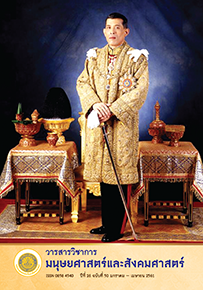แนวทางการสอนคำศัพท์ภาษาเกาหลีแก่ผู้เรียนชาวไทย: กรณีฮันจา (ตัวอักษรจีนในภาษาเกาหลี) A Study on Educational Method of Korean Vocabulary for Thai Learners: A Focus on Hanja (Sino-Korean Words)
Main Article Content
Abstract
กลวิธีในการเรียนการสอนคำศัพท์คือ ผู้เรียนต้องสามารถเข้าใจคำศัพท์ให้ได้มากที่สุดและให้เกิดความลำบากน้อยที่สุดในการจดจำ โดยการหาความสัมพันธ์ระหว่างคำศัพท์จะเป็นการช่วยให้เกิดผลสัมฤทธิ์ที่มากขึ้นในการเรียน จุดประสงค์ในการเรียนการสอนคำศัพท์ ประกอบด้วย ส่งเสริมความสามารถในการเพิ่มพูนคำศัพท์ด้วยตนเอง สร้างสรรค์พจนานุกรมออนไลน์ให้เป็นตำรา และส่งเสริมความคิดในการเปรียบเทียบภาษาไทยกับภาษาเกาหลี
จุดประสงค์ของบทความนีคื้อ นำเสนอวิธีการเรียนสอนคำศัพท์ภาษาเกาหลีแก่ผู้เรียนชาวไทย โดยมุ่งเน้นไปที่คำ ‘ฮันจา’ ซึ่งเป็นคำที่มาจากตัวอักษรจีน และใช้พจนานุกรมออนไลน์เป็นเครื่องมือ อย่างไรก็ตามรูปแบบของเนื้อหาจะมีความแตกต่างจากการเรียนการสอน ‘คำศัพท์ภาษาเกาหลีแท้’ เนื่องจากคำสองชนิดนีมี้ลักษณะทางรูปแบบแตกต่างกัน
ผู้เรียนจะหาความสัมพันธ์ระหว่างคำจากคำศัพท์พื้นฐานที่ได้รับมอบหมายซึ่งเป็นความสัมพันธ์เชิงผสมผสาน (Combination relationship) โดยใช้พจนานุกรมออนไลน์เป็นเครื่องมือในการสืบค้นสำรวจข้อมูล ซึ่งมีเกณฑ์ที่เกี่ยวข้องสำหรับสำรวจฮันจา 3 ประการ คือ 1) จำนวนพยางค์ 2) ตำแหน่ง และ 3) ความหมายจากนั้นกรอกข้อมูลลงในตารางที่กำหนดให้ พร้อมแปลข้อมูลหรือตัวอย่างเป็นภาษาไทยแนบต้นฉบับภาษาเกาหลี และนำมารายงานหน้าชั้น
It is simple to state that a technique to gain vocabulary is that learners have to learn as many vocabulary items as they can with the least difficulty in remembering them. Hence, to facilitate learners, an instructor has to apply morphological knowledge into teaching. The objectives of this study are 1) to enhance self-study ability for learning vocabulary, 2) to implement on-line dictionary as a textbook, and 3) to promote Thai-Korean comparative concept.
The object of this paper is to propose method for teaching Thai learners Korean vocabularies. It is to focus on ‘Hanja (Sino-Korean Words)’ through on-line dictionaries. However, the contents of education methods are different from native Korean words because their morphological characteristics are different.
The learners need to make use of on-line dictionary to seek the relationship between the appointed foundation words consisting of vocabulary with combination relationship. After that, the learners are asked to fill in the table with information they gain. The determinants for seeking related Sino-Korean words are 1) number of syllables, 2) position in a word, and 3) its meaning. They then have to translate the information or examples from Korean into Thai and present them in the class.
Downloads
Article Details
บทความทุกบทความเป็นลิขสิทธิ์ของวารสารวิชาการมนุษยศาสตร์และสังคมศาสตร์ มหาวิทยาลัยบูรพาเท่านั้น
References
มนุษยศาสตร์และสังคมศาสตร์, 25(49), 1-11.
Kim, ChangSop. (2001). Word-formation in Sino-Korean and a Constraint of the Grammar of Native Korean. Journal
of Korean Linguistics ,37,177-195.
Park, Hye Jin. (2010). A Study on the Contents in Word-formation. Republic of Korea: M.Ed. Thesis, Seoul National
University.
Park, Hyong Ik. (2004). han-gu-geui sa-jeon-gwa sa-jeon-hak (KoreanDictionaries and Lexicography). Seoul, Korea:
weo-rin.Kim, ChangSop. (2001). Word-formation in Sino-Korean and a Constraint of the Grammar of Native Korean. Journal of Korean Linguistics, 37, 177-195.
Shim, Jae Gi. (1987). han-ja-eo-eui ku-jo-wa keu co-eo-ryeok (Sino-Korean words structures and word formations). ku-geo saeng-hwal, 8, 25-39.
Shin, Myeong Seon. (2011). ku-geo-gwa eo-hui kyo-yuk nae-yong-eui yu-hyeong-hwa-etae-han yeon-gu (The
Classification of Korean Vocabulary Educative Contents). Korean language educationresearch, 40, 61-101.
Won, Mi Jin. (2014). A Study on Selection of Derivational Affixes for Vocabulary Education of Korean language
Learners. han-guk sa-jeon-hak ,23,180-204.


